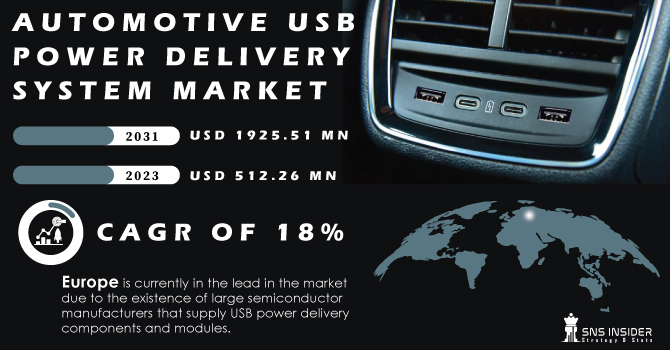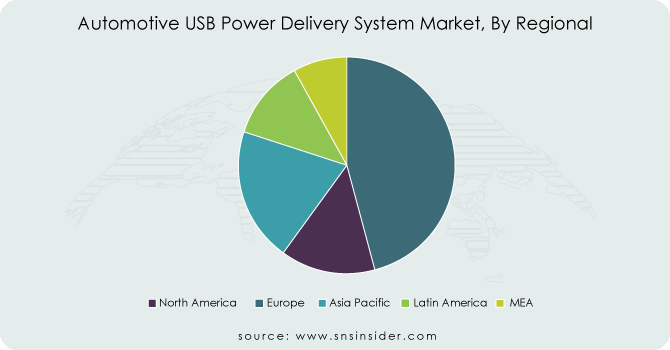Automotive USB Power Delivery System Market Report Scope & Overview:
The Automotive USB Power Delivery System Market Size was valued at USD 512.26 million in 2023 and is expected to reach USD 1925.51 million by 2031 and grow at a CAGR of 18% over the forecast period 2024-2031.
A USB power delivery system is a sort of equipment that can be installed in a car in order to provide the driver as well as the passengers with the ability to charge their mobile phones, laptops, and other portable electronic devices. There are several different types of USB power supply methods, including Type A, Type C, USB 1.0, and USB 2.0, which can be used singly or in combination with one another. Because the USB power delivery system helps enable the connection of various devices with varying power profiles and is also compatible with the various multimedia interfaces, the convenience and comfort of the passengers are increased.

Get More Information on Automotive USB Power Delivery System Market - Request Sample Report
The automotive USB power delivery system enables the vehicle and consumer devices, including mobile phones, laptops, and other portable electronic gadgets, to share data and power in an intelligent, dependable, and efficient manner. The global market for automotive USB power supply systems is expanding at a rapid rate as a result of the increasing demand for entertainment systems in automobiles and the rising sales of type C USB.
MARKET DYNAMICS:
KEY DRIVERS:
-
Demand for automotive infotainment systems has increased in recent years
-
Increase in demand for original, high-quality, and fast-shipping electrical components
-
Demand for more modern charging methods in personal vehicles is on the increase
-
The increasing use of USB systems in car head units, DVD players, and other electronic devices
-
Due to a surge in disposable income, automobile production has increased
RESTRAINTS:
-
The surge in USB device failures is caused by power variations
-
During the projected period, the market's growth could be hampered if USB devices fail to owe to power variations
OPPORTUNITIES:
-
Progress in technological innovation and modernization of manufacturing methods
-
Rises in market research and development
-
New opportunities will be created as a result of an increase in demand from developing countries
CHALLENGES:
-
During the projected period, the market's growth could be hampered if USB devices fail to owe to power variations
-
The surge in USB device failures is caused by power variations
IMPACT OF COVID-19:
Due to the current scenario with the coronavirus, the report anticipates that the global market for Automotive USB Power Delivery Systems will reach several millions of US dollars in 2022, with an increase of double-digit growth throughout the timeframe of 2024-2031. This report offers a comprehensive analysis of the Automotive USB Power Delivery System Market sector as well as the significant market changes caused by a coronavirus. The research on the market includes information on the past and the future of the market, as well as demand, application data pricing, trends in price, and shares of businesses in the top Automotive USB Power Delivery System Market by geography. The size of the Automotive USB Power Delivery System Market is broken down into volume and value in this report, with each type of application and geographic area accounting for a separate division.
MARKET SEGMENTATION:
By Type:
-
Combination
-
Type C
Based on the type segment, the global market has been divided into the combination, and type C. During the projected period, the market is expected to be dominated by the combination segment. The global automotive USB power delivery system market is predicted to see an increase in demand for combination-type USB ports due to the increasing desire for fast charging and compatibility with a variety of vehicle infotainment systems.
By Application:
-
Head units
-
Rear-Seat Entertainment
-
Rear-Seat Chargers
The global market has been divided into Head units, Rear-Seat Entertainment, and Rear-Seat Chargers based on the application segment. For the foreseeable future, the global market for head units is projected to be dominated by this particular product category. Demand for head units in the global automotive USB power delivery system market is predicted to expand with the increasing demand for enhanced infotainment applications in automobiles.
By Distribution:
-
Online
-
Offline
The global market has been divided into online, and offline based on the distribution segment. The worldwide market is expected to be dominated by the online sector. The global automotive USB power delivery system market's online distribution channel demand is predicted to expand in response to the increasing need for genuine and high-quality electronic components in automobiles.
REGIONAL ANALYSIS:
The regions of North America, Europe, Asia-Pacific (APAC), and the Rest of the World are included in the region-specific analysis of the vehicle USB power delivery system market. Europe is currently in the lead in the market due to the existence of large semiconductor manufacturers that supply USB power delivery components and modules. This has propelled Europe to the position of a market leader. Over the course of the projected period, the strict laws and standards imposed by the government will boost the demand for vehicles of the next generation, such as electric and hybrid vehicles, which will, in turn, generate the requirement for automotive USB power delivery systems. Nevertheless, during the time covered by the forecast, analysts anticipate that Asia-Pacific would show the greatest rate of expansion. The existence of numerous significant semiconductor manufacturers. These firms are continually developing the components and modules for power delivery that are offered to various industries, such as the automotive and electronics industries, for the purpose of data transmission and power transfer respectively.

Get Customized Report as per your Business Requirement - Ask For Customized Report
REGIONAL COVERAGE:
North America
-
US
-
Canada
-
Mexico
Europe
-
Eastern Europe
-
Poland
-
Romania
-
Hungary
-
Turkey
-
Rest of Eastern Europe
-
-
Western Europe
-
Germany
-
France
-
UK
-
Italy
-
Spain
-
Netherlands
-
Switzerland
-
Austria
-
Rest of Western Europe
-
Asia Pacific
-
China
-
India
-
Japan
-
South Korea
-
Vietnam
-
Singapore
-
Australia
-
Rest of Asia Pacific
Middle East & Africa
-
Middle East
-
UAE
-
Egypt
-
Saudi Arabia
-
Qatar
-
Rest of Middle East
-
-
Africa
-
Nigeria
-
South Africa
-
Rest of Africa
-
Latin America
-
Brazil
-
Argentina
-
Colombia
-
Rest of Latin America
KEY PLAYERS:
Cypress Semiconductor Corporation (US), Infineon Technologies AG (Germany), Lattice Semiconductor (US), NXP Semiconductors (Netherlands), Renesas Electronics Corporation (Japan), Texas Instruments Incorporated (US), ON Semiconductor (US), ROHM Semiconductor (Japan), and STMicroelectronics (Switzerland) are some of the affluent competitors with significant market share in the Automotive USB Power Delivery System Market.
Infineon Technologies AG (Germany)-Company Financial Analysis

| Report Attributes | Details |
|---|---|
| Market Size in 2023 | US$ 512.26 Million |
| Market Size by 2031 | US$ 1925.51 Million |
| CAGR | CAGR of 18% From 2024 to 2031 |
| Base Year | 2023 |
| Forecast Period | 2024-2031 |
| Historical Data | 2020-2022 |
| Report Scope & Coverage | Market Size, Segments Analysis, Competitive Landscape, Regional Analysis, DROC & SWOT Analysis, Forecast Outlook |
| Key Segments | • by Type (Combination, Type C) • by Application (Head units, Rear-Seat Entertainment, Rear-Seat Chargers) • by Distribution (Online, Offline) |
| Regional Analysis/Coverage | North America (US, Canada, Mexico), Europe (Eastern Europe [Poland, Romania, Hungary, Turkey, Rest of Eastern Europe] Western Europe] Germany, France, UK, Italy, Spain, Netherlands, Switzerland, Austria, Rest of Western Europe]), Asia Pacific (China, India, Japan, South Korea, Vietnam, Singapore, Australia, Rest of Asia Pacific), Middle East & Africa (Middle East [UAE, Egypt, Saudi Arabia, Qatar, Rest of Middle East], Africa [Nigeria, South Africa, Rest of Africa], Latin America (Brazil, Argentina, Colombia, Rest of Latin America) |
| Company Profiles | Cypress Semiconductor Corporation (US), Infineon Technologies AG (Germany), Lattice Semiconductor (US), NXP Semiconductors (Netherlands), Renesas Electronics Corporation (Japan), Texas Instruments Incorporated (US), ON Semiconductor (US), ROHM Semiconductor (Japan), and STMicroelectronics (Switzerland) |
| Key Drivers | •Demand for automotive infotainment systems has increased in recent years. •Increase in demand for original, high-quality, and fast-shipping electrical components. •Demand for more modern charging methods in personal vehicles is on the increase. |
| RESTRAINTS | •The surge in USB device failures is caused by power variations. •During the projected period, the market's growth could be hampered if USB devices fail to owe to power variations. |

